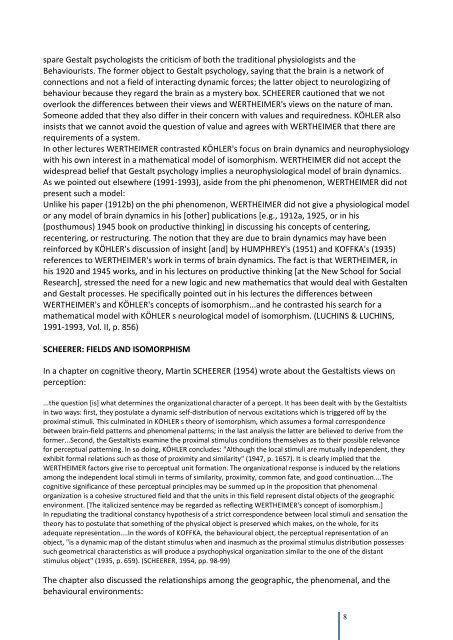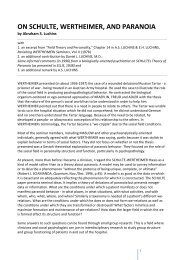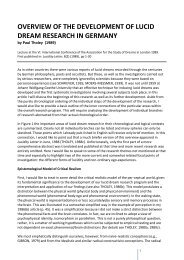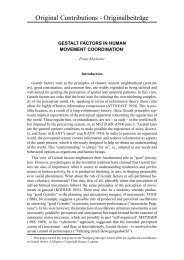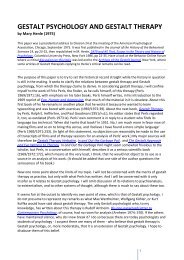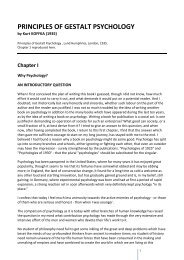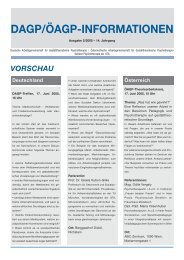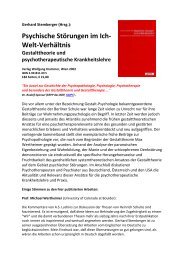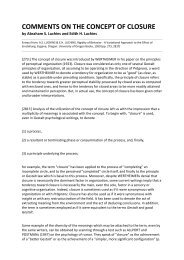pdf-Download - Society for Gestalt Theory and its Applications (GTA)
pdf-Download - Society for Gestalt Theory and its Applications (GTA)
pdf-Download - Society for Gestalt Theory and its Applications (GTA)
Create successful ePaper yourself
Turn your PDF publications into a flip-book with our unique Google optimized e-Paper software.
spare <strong>Gestalt</strong> psychologists the criticism of both the traditional physiologists <strong>and</strong> theBehaviourists. The <strong>for</strong>mer object to <strong>Gestalt</strong> psychology, saying that the brain is a network ofconnections <strong>and</strong> not a field of interacting dynamic <strong>for</strong>ces; the latter object to neurologizing ofbehaviour because they regard the brain as a mystery box. SCHEERER cautioned that we notoverlook the differences between their views <strong>and</strong> WERTHEIMER's views on the nature of man.Someone added that they also differ in their concern with values <strong>and</strong> requiredness. KÖHLER alsoinsists that we cannot avoid the question of value <strong>and</strong> agrees with WERTHEIMER that there arerequirements of a system.In other lectures WERTHEIMER contrasted KÖHLER's focus on brain dynamics <strong>and</strong> neurophysiologywith his own interest in a mathematical model of isomorphism. WERTHEIMER did not accept thewidespread belief that <strong>Gestalt</strong> psychology implies a neurophysiological model of brain dynamics.As we pointed out elsewhere (1991-1993), aside from the phi phenomenon, WERTHEIMER did notpresent such a model:Unlike his paper (1912b) on the phi phenomenon, WERTHEIMER did not give a physiological modelor any model of brain dynamics in his [other] publications [e.g., 1912a, 1925, or in his(posthumous) 1945 book on productive thinking] in discussing his concepts of centering,recentering, or restructuring. The notion that they are due to brain dynamics may have beenrein<strong>for</strong>ced by KÖHLER's discussion of insight [<strong>and</strong>] by HUMPHREY's (1951) <strong>and</strong> KOFFKA's (1935)references to WERTHEIMER's work in terms of brain dynamics. The fact is that WERTHEIMER, inhis 1920 <strong>and</strong> 1945 works, <strong>and</strong> in his lectures on productive thinking [at the New School <strong>for</strong> SocialResearch], stressed the need <strong>for</strong> a new logic <strong>and</strong> new mathematics that would deal with <strong>Gestalt</strong>en<strong>and</strong> <strong>Gestalt</strong> processes. He specifically pointed out in his lectures the differences betweenWERTHEIMER's <strong>and</strong> KÖHLER's concepts of isomorphism...<strong>and</strong> he contrasted his search <strong>for</strong> amathematical model with KÖHLER s neurological model of isomorphism. (LUCHINS & LUCHINS,1991-1993, Vol. II, p. 856)SCHEERER: FIELDS AND ISOMORPHISMIn a chapter on cognitive theory, Martin SCHEERER (1954) wrote about the <strong>Gestalt</strong>ists views onperception:...the question [is] what determines the organizational character of a percept. It has been dealt with by the <strong>Gestalt</strong>istsin two ways: first, they postulate a dynamic self-distribution of nervous excitations which is triggered off by theproximal stimuli. This culminated in KÖHLER s theory of isomorphism, which assumes a <strong>for</strong>mal correspondencebetween brain-field patterns <strong>and</strong> phenomenal patterns; in the last analysis the latter are believed to derive from the<strong>for</strong>mer...Second, the <strong>Gestalt</strong>ists examine the proximal stimulus conditions themselves as to their possible relevance<strong>for</strong> perceptual patterning. In so doing, KÖHLER concludes: "Although the local stimuli are mutually independent, theyexhibit <strong>for</strong>mal relations such as those of proximity <strong>and</strong> similarity" (1947, p. 1657). It is clearly implied that theWERTHEIMER factors give rise to perceptual unit <strong>for</strong>mation. The organizational response is induced by the relationsamong the independent local stimuli in terms of similarity, proximity, common fate, <strong>and</strong> good continuation....Thecognitive significance of these perceptual principles may be summed up in the proposition that phenomenalorganization is a cohesive structured field <strong>and</strong> that the un<strong>its</strong> in this field represent distal objects of the geographicenvironment. [The italicized sentence may be regarded as reflecting WERTHEIMER's concept of isomorphism.]In repudiating the traditional constancy hypothesis of a strict correspondence between local stimuli <strong>and</strong> sensation thetheory has to postulate that something of the physical object is preserved which makes, on the whole, <strong>for</strong> <strong>its</strong>adequate representation....In the words of KOFFKA, the behavioural object, the perceptual representation of anobject, "is a dynamic map of the distant stimulus when <strong>and</strong> inasmuch as the proximal stimulus distribution possessessuch geometrical characteristics as will produce a psychophysical organization similar to the one of the distantstimulus object" (1935, p. 659). (SCHEERER, 1954, pp. 98-99)The chapter also discussed the relationships among the geographic, the phenomenal, <strong>and</strong> thebehavioural environments:8


